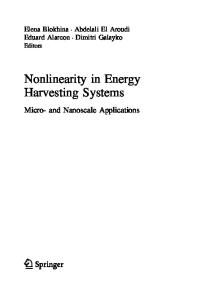Deformation Mapping in Micro- and Nanoscale Fibers
- PDF / 888,768 Bytes
- 6 Pages / 612 x 792 pts (letter) Page_size
- 56 Downloads / 344 Views
1185-II04-02
Deformation Mapping in Micro- and Nanoscale Fibers Christina Garman1, Natalie Bindert2, Adhira Sunkara3,4, Leocadia Paliulis5, and Donna M. Ebenstein3 1
Computer Science Department, Bucknell University, Lewisburg, PA 17837, U.S.A. Mechanical Engineering Department, Bucknell University, Lewisburg, PA 17837, U.S.A. 3 Biomedical Engineering Department, Bucknell University, Lewisburg, PA 17837, U.S.A. 4 Biomedical Engineering Department, Washington University, St. Louis, MO 63130, U.S.A. 5 Biology Department, Bucknell University, Lewisburg, PA 17837, U.S.A. 2
ABSTRACT Small-scale natural fibers are among the biological materials being studied by researchers seeking innovative methods to create new high performance materials. For example, spider dragline silk fibers are being studied because of their unique combination of high strength-toweight ratio and high extensibility, which leads to a tough and lightweight fiber. Biomimetic fibers based on spider silk have been a focus of research for the past decade. However, there are still many unanswered questions about the mechanisms by which silk achieves its unique mechanical properties, as well as challenges in mechanical testing of biomimetic silk fibers (which is often hindered by both small diameters and limited material availability). A method to characterize local mechanical behavior in small diameter fibers was developed to both improve understanding of structure-property relationships in natural fibers and provide a method for comparing mechanical behavior in natural and biomimetic fibers. The deformation mapping technique described in this paper, which utilizes a piezoelectric micromanipulator with pulled glass tips, an inverted microscope with attached camera, and an image processing MATLAB program, is also applicable to the characterization of other micro- and nanoscale fibers where local deformation mechanisms may be of interest (e.g., for mechanical characterization of electrospun fibers). INTRODUCTION Small-scale natural fibers are among the biological materials being studied in the field of biomimetics, or applying lessons learned from nature to solve engineering problems. Natural fibers often have superior mechanical properties to traditional synthetic polymer fibers. For example, spider dragline silk fibers (with diameters of 5-10 microns) have a unique combination of high strength-to-weight ratio and high extensibility, which leads to a tough and lightweight fiber [1]. Such properties would be desirable to achieve for fibers to be used in clothing, sutures, and other applications requiring a strong, tough and lightweight fiber. Biomimetic fibers based on spider silk have been a focus of research for the past decade [1]. However, there are still many unanswered questions about the mechanisms by which silk achieves its unique mechanical properties. Additionally, as researchers work to develop biomimetic fibers, mechanical testing is often hindered by both small diameters and limited availability of the experimental materials. For example, many
Data Loading...









